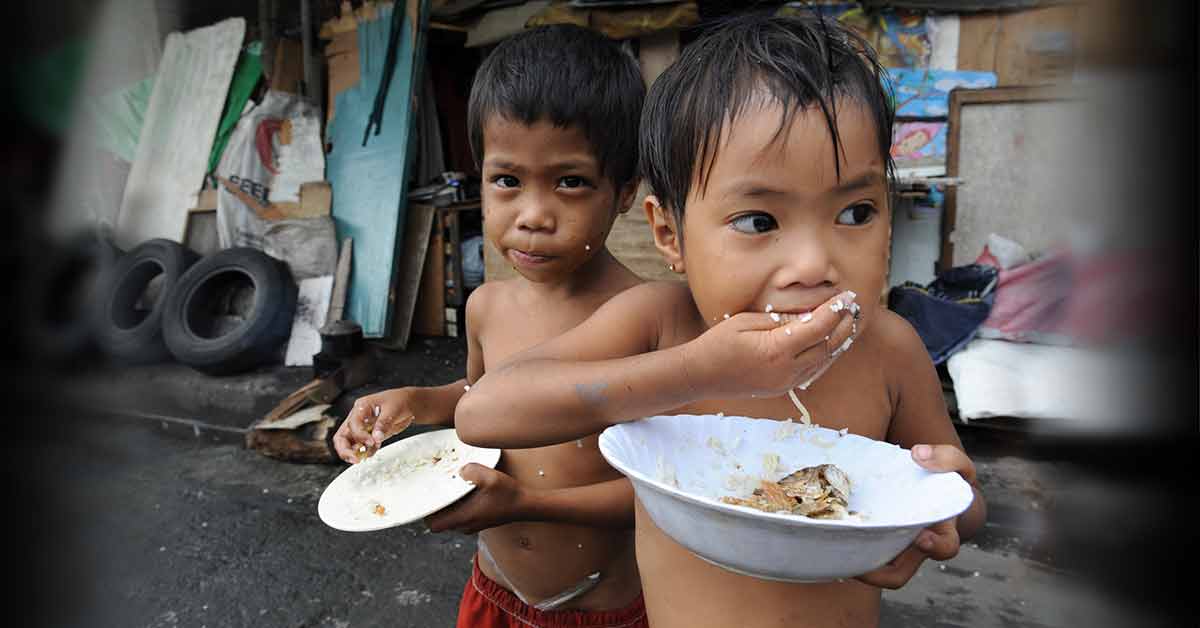The COVID-19 crisis is the worst crisis that has plagued the world since the Great Depression. It is continuously devastating economies, people’s lives, jobs, and businesses around the globe. One of the unsettling impacts of the coronavirus pandemic is the disruption in achieving the objectives of the 2030 Agenda for Sustainable Development Goals (SDGs), more particularly that which pertains to SDG 2 - hunger.
The 2030 Agenda for Sustainable Development, which has 17 Global Goals, basically calls on the global community to place the world’s most vulnerable and marginalised people, including children, at the top of the agenda. It was adopted on the 25 September, 2015 by world leaders at the conclusion of the post-2015 intergovernmental negotiations.
The 2030 SDG Agenda wants to build a better future for all people, especially those who have been neglected and deprived of the chance to live dignified lives to achieve their full potential by ending poverty, reducing inequalities, and saving the planet from ecological degradation and climate change.
It is, in essence, the blueprint to a better future for the planet and the human race. It holds everyone responsible and accountable in ensuring that the journey is successful and the gains are sustainable.
SDGs And The Philippines
In a global ranking before the pandemic, the Philippines like most ASEAN countries had an index score of 65.0 out of 100 points. Its regional average score was 64.1 and its SDG global rank was 85 in implementing SDGs among the list of countries. This is a bit above the ASEAN average of 63.3, where a score of 50 means that countries are halfway through achieving the SDGs. At the time, this was quite promising.
Based on the SDG Index before the pandemic, the Philippines fared positively on SDG 1 (no poverty); SDG 4 (quality education); SDG 6 (clean water and sanitation); SDG 12 (responsible consumption and production); and SDG 13 (climate change). But then again, this may not be the case anymore amid the pandemic.
However, the Philippines did not fare well on SDG 2 – “zero hunger” before the pandemic, and this may have even worsened at the onset of the COVID-19 crisis.
Hunger Amid The Pandemic
According to the United Nations World Food Programme (UNWFP), the impact of the pandemic on hunger has been cruel for low-middle income countries and that includes the Philippines. The pandemic may cause “a food security and nutrition crisis of historic proportions.”
The UNWFP also warns that an additional 200 million people around the world are expected to lose access to basic food and nutrition as the pandemic drags-on on top of the more than 800 million people who were already food-insecure before COVID-19. That means about one billion of the world population will be facing hunger.
In the Philippines, based on the 2019 fourth quarter Social Weather Stations (SWS) survey, 8.8 percent of households or roughly 2.1 million Filipino families experienced involuntary hunger once in three months, a slight improvement over the 9.1 percent or 2.3 million families logged in September 2019.
Moreover, based on the SWS survey in July 2020, the hunger rate in the Philippines has deteriorated with at least one out of every five Filipinos experiencing voluntary hunger from May to July, 2020.
The hunger rate in the country based on the SWS survey was recorded at 20.9 percent or 5.2 million Filipinos and thus far is the highest hunger rate recorded since September 2014 of around 22 percent. Whereas, the 17-20 September, 2020 SWS National Mobile Phone Survey revealed that around 22 percent or 24.1 million individuals experienced hunger once or a few times, and around 8.7 percent or 9.5 million individuals experienced hunger often or always.
Likewise, the 2019 Global Hunger Index, ranked the Philippines at 70th out of 117 countries at a level classified as serious.
Impact Of Hunger On Children
According to the United Nations Children's Fund (UNICEF), 95 Filipino children die every day from malnutrition. That’s about 34,675 children dying from poor nutrition and hunger every year before the pandemic. Hunger and malnutrition among Filipino children could possibly be worse now than before the pandemic.
Based on 2019 statistics on malnutrition among children under five-years-old from the Department of Science and Technology-Food and Nutrition Research Institute (DoST-FNRI), 28.8 percent or 3.2 million are stunted, which is lower compared to the 30.3 percent recorded in 2018; 19.0 percent or 2.1 million are underweight, and 5.8 percent or 0.6 million are wasting.
However, this situation may have worsened following the pandemic due to the rise in the level of hunger in the country.
To note, stunting is the impaired growth and development that children experience from poor nutrition, repeated infection, and inadequate psychosocial stimulation. Usually, stunted children have a low height for their age, while wasting causes a person or a part of the body to become progressively weaker and more emaciated.
Food Security Initiatives
According to Cabinet Secretary Karlo Nograles, given the negative impact of the COVID-19 crisis on the hunger situation in the country, the Philippine government is doubling its efforts to address food security. Nograles said, “the administration is fully committed to ensuring food security and addressing hunger through programs that strengthen agricultural yield and increase the income of farmers.
The efforts of the Philippine government to address hunger is being spearheaded and coordinated by the “Zero Hunger Task Force (ZHTF),” which was formed under Executive Order 101, that aims to eliminate hunger by addressing food security, improving general nutrition, and developing sustainable agriculture by 2030.
The ZHTF is chaired by Nograles and is mandated to review existing laws, regulations, and rules relative to food security, and to recommend measures to improve these. It is also tasked to carefully coordinate, rationalise, monitor, and assess the efforts of involved government agencies to ensure not only a whole-of-nation approach but a whole-of-society collaboration in eradicating hunger and achieving food security.

Just recently, the ZHTF launched the country’s National Food Policy (NFP) on World Food Day. The NFP is a long-term, cohesive strategy that involves initiatives for ending hunger, achieving food security, improving nutrition, and promoting sustainable agriculture. The goal of the NFP is to end hunger in the Philippines “within this generation’s lifetime.”
The ZHTF also launched the “Bangsamoro Autonomous Region in Muslim Mindanao (BARMM) Food Security and Nutrition (FSN) Roadmap”. The two initiatives cement the government’s commitment to addressing involuntary hunger, food security, undernutrition, child wasting, stunting, and mortality.
Another concrete program under the ZHTF, which addresses hunger and ensures food security in the country amid the coronavirus pandemic is the Enhanced Partnership Against Hunger and Poverty (EPAHP) program in various provinces in Central Luzon. The key focus of the EPAHP is to ensure the “availability and accessibility of food products and ensure the capability of farmers to produce.”
A key element of the EPAHP is credit support for food production, processing, and marketing for community-based organisations (CBOs) through the Landbank and other agencies. The EPAHP is tied to the SDGs and the Philippine Development Plan 2017-2022, which is part of the poverty reduction efforts of the government.
Likewise, the “Plant Plant Plant” program of the Department of Agriculture (DA) also aims to ensure food security in the country. The rationale behind this program is to ensure a more self-reliant and resilient Philippines amid the pandemic and in the post-pandemic era.
Feeding Program For Children
In addressing stunting, malnutrition, and wasting among Filipino children, the feeding program for children initiative of the government will continue despite blended learning approaches in schools amid the pandemic.
Instead of preparing hot meals for students, nutritious food products will be delivered to households or picked up by parents from schools. Presidential Spokesperson Harry Roque said that, “the barangay will deliver the free nutritious lunch right to their homes.”
According to the Department of Education, due to changes in the school calendar, the feeding period for this school year has been reduced to 60 days for the regular component, which includes nutritious food products, and 50 days for the milk component.
The said government initiative is in pursuance of Republic Act No. 11037 or the “Masustansyang Pagkain Para sa Batang Pilipino Act (Nutritious Food for the Filipino Children Act), which establishes a national feeding program for undernourished children in public day-care centres, kindergartens, and elementary schools.
The law which was signed by President Duterte in June 2018 states that the government shall provide a supplemental feeding program for day-care children, a school-based feeding program for public school children from Kinder to Grade 6, a milk-feeding program, a micronutrient feeding program, health examinations, vaccinations, and deworming among others.
The law also includes the creation of a National Nutrition Information System which will harmonise all existing national and local nutrition databases to identify individuals, groups, and/or localities that have the highest magnitude of hunger and undernutrition.
Conclusion
The issue of food security and hunger, to a considerable degree, has been given much attention by the Philippine government. Nevertheless, the government must increase its efforts and address the necessary legislative/policy measures that will further facilitate a more vibrant food/agricultural sector as it is not only indispensable in preventing stunting and malnutrition among children but is equally vital in managing a pandemic; more importantly in feeding the population of the country sustainably.
One of the important legislative measures that Congress needs to pass is the National Land Use Act (NLUA), which is a critical tool needed to ensure the country’s food security. The NLUA would ensure the rational and sustainable use of the country’s land and physical resources, as well as harmonise sector-specific land-use policies and institutionalise land use planning.
According to Nograles, “when we talk about food production, food availability, food price stability, and helping small farmers, the land is important. NLUA can ensure that agricultural lands are not converted, as it will allow us to identify land that will be used for agricultural purposes.”
Related Articles:

